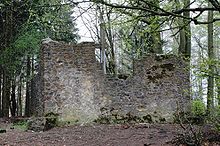Hünenkapelle (Oerlinghausen)
The Hünenkapelle (also called Hünenkirche , Tönskapelle or Antoniuskapelle ) on the back of the Tönsberg in Oerlinghausen is the ruin of an early medieval hall church , of which only the surrounding walls are preserved today. It is surrounded by a ring wall system known as the “ Sachsenlager ”. It forms one of five pre-Christian fortifications in Lippe . The Hünenkapelle is registered with the number 42 as an architectural monument in the municipal monument list.
There are no written reports about the origin of the giant chapel. The historian Nicolaus Schaten interpreted it in the 17th century as a thank-you chapel of Charlemagne for his victory over the Saxons. The chapel is said to have been a place of pilgrimage for pilgrims for a long time. In the attic there was a small chamber in which a hermit is said to have lived who took care of the maintenance of the chapel. The chapel was dedicated to the patron saint of the hermits, Saint Anthony . The original cross in the giant chapel was moved to the crypt of Paderborn Cathedral after the chapel was destroyed in 1548 , where it is still kept today.
In the chapel today there is a wooden cross about two meters tall with the inscription "Im Kreuz ist Heil" (a quote from Thomas von Kempen ). The cross was consecrated in a divine service in 1977. Before that there was also a cross in the chapel, this was erected in 1953 by members of the Catholic Youth .
Around 1930 Hermann Diekmann assumed that the chapel was the location of the Irminsul . This thesis was widely disseminated, also outside of Lippe, by Hans Reinerth . However, this theory was a minority opinion even then and is now considered refuted. Nevertheless, it is the reason why some groups of the Asatru still see the Tönsberg as a place of worship and Christian symbols such as the wooden cross are repeatedly destroyed in the area of the chapel.
The Oerlinghausen Archaeological Open-Air Museum offers guided tours of the facility. Since 1996, a meditation path has led over the Tönsberg to the ruins.
In Hermann Löns ' description of woman loneliness , published in 1911 in the volume Da outside before the gate. Local nature images, the giant chapel is mentioned; It says there: "... So I climbed uphill, past the giant chapel on the Tönsberg, through beech forest, in whose shade the blackberry bushes burst ..." .
The burial chapel was in 1923 on a Notgeldschein of Lippe Bank displayed.
Detail of the wooden cross with the saying "In the cross is salvation" by Thomas von Kempen .
literature
- Handbook of the Historical Places of Germany , Vol. 3. Stuttgart 1963.
References
- ↑ Deutschlandradio Kultur : Quiet Times in Oerlys
- ^ Corina Lass: Signs of contradiction. Why neo-pagan groups make a pilgrimage to the giant chapel on the Tönsberg. In: Neue Westfälische , 196th volume, No. 180/2006.
- ^ Johann Stefan Müller: The Oerlinghauser Meditation Path. Oerlinghausen, 1988
- ↑ Hermann Löns: Woman loneliness . In: Out there in front of the gate. Local nature pictures, Warendorf 1911
Web links
Coordinates: 51 ° 56 ′ 49 " N , 8 ° 41 ′ 45" E





